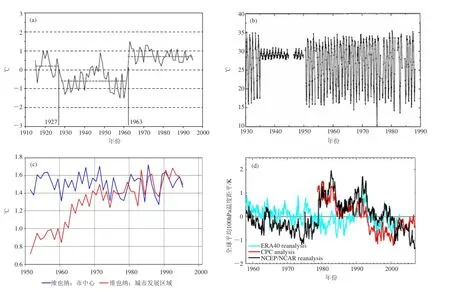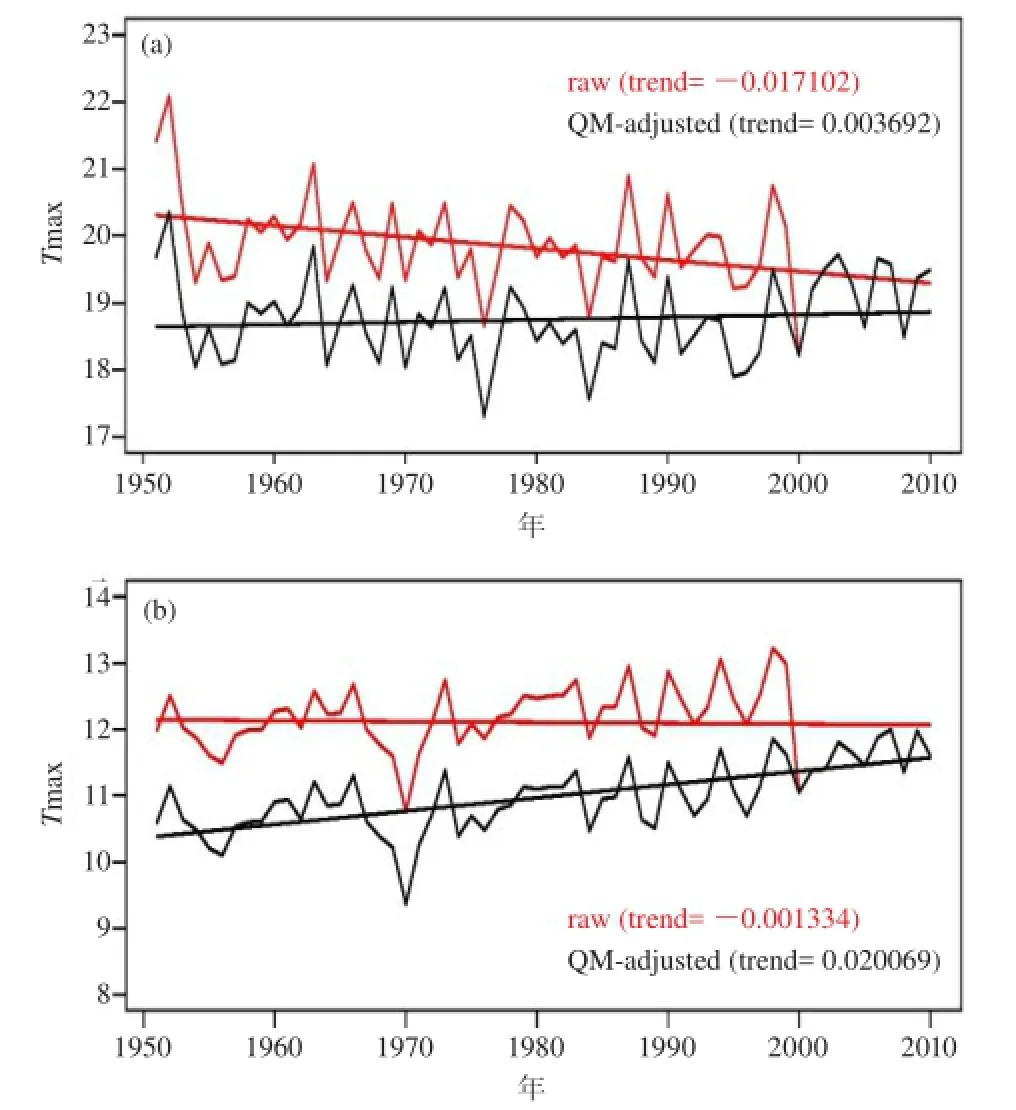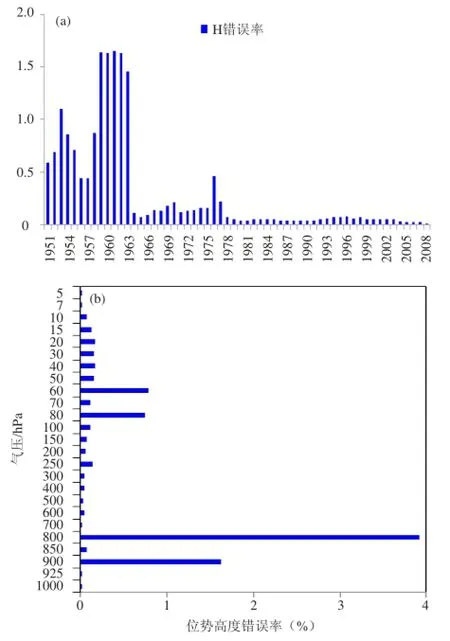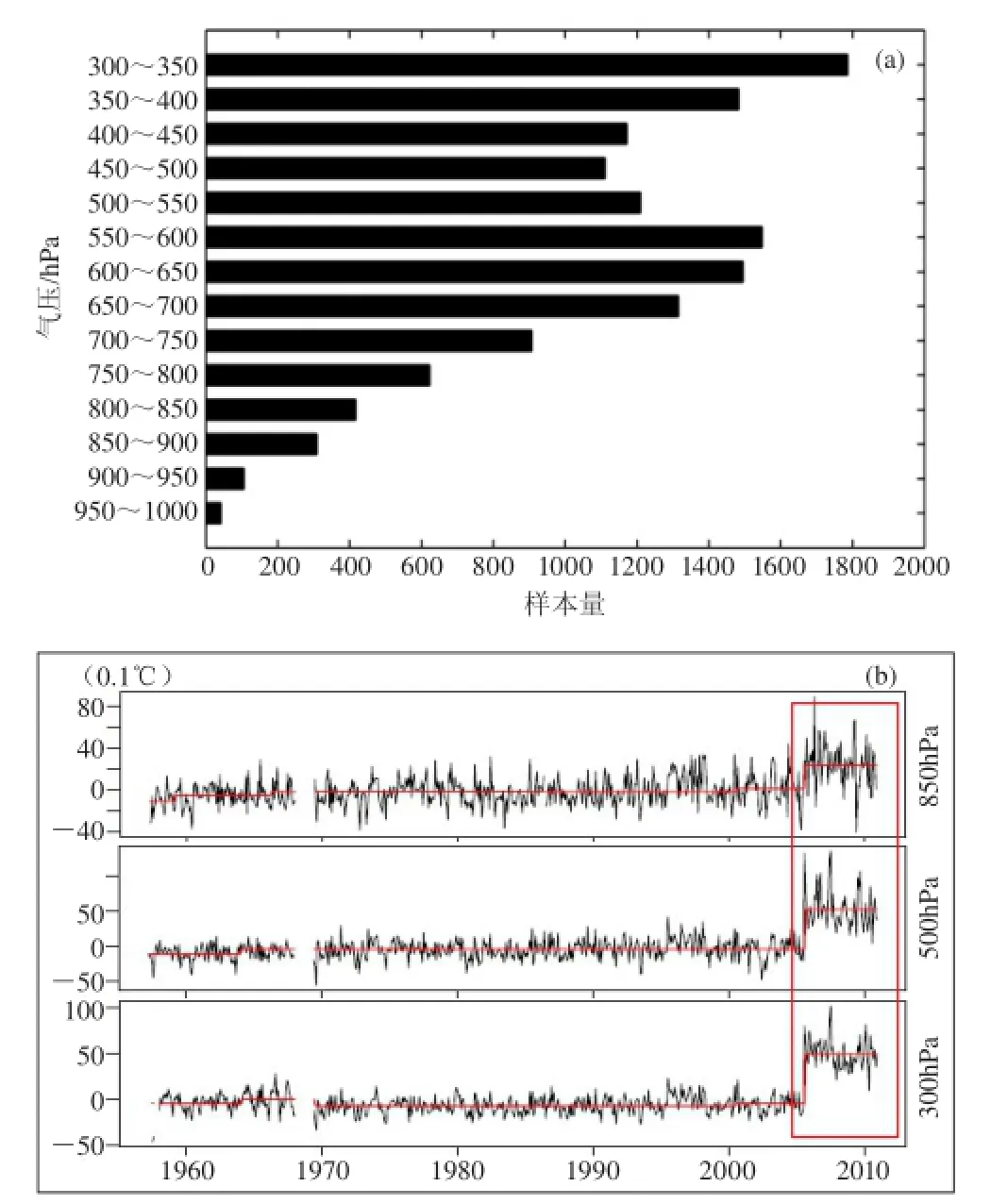我国气候资料均一性研究现状与展望
2016-11-16李庆祥
李庆祥
(国家气象信息中心,北京 100081)
我国气候资料均一性研究现状与展望
李庆祥
(国家气象信息中心,北京 100081)
时空均一的气候资料是气象科研、业务和服务的基础。介绍了气候资料均一性的基本概念、涉及范围、主要原因以及解决非均一性问题的意义。在此基础上,阐述了国际上气候资料均一性研究的动态和技术发展历程,指出以高时空分辨率的均一化为标志的第二代气象数据产品研发趋势为气候资料均一性研究带来良好的发展机遇和严峻的挑战;结合对我国地面、高空和辐射三类气候资料均一性概况和相关研究现状的总结,分析了我国在相关领域研究的深度和广度上存在的差距和不足,以及当前需要解决的关键科学和技术问题。最后,就如何正确认识气候资料的均一性,如何深化我国气候资料均一性研究,加强气候数据产品研发,实现我国数据产品研发技术和管理水平上一个新台阶等提出了建议。
气候资料,均一性,气候变化,城市化,第二代数据产品
0 引 言
和天气资料不同,在某种意义上气候资料是“二手”资料,即需要对采集、积累的原始资料进行加工,才能形成。资料的均一性是气候资料的核心要件之一。气候资料均一性一般可用其反面更加清晰地阐述:即所谓气候资料的非均一性,就是气候资料序列中由于非气候原因造成的、相对于自然变率不可忽视的系统性差异。从时空的角度上讲,气候资料的非均一性可以分为空间的非均一性和时间上的非均一性(不连续性)。在同一观测站网络得到的观测序列中,一般考虑得较多的是时间上(即气候序列)的均一性。而采用不同观测网络(如不同国家的站网,不同类型、级别的站网)的资料进行合并处理时,则还需要考虑空间的均一性。
均一性的气候数据对历史气候趋势和变率的研究,尤其对于气候态和极端事件的研究非常重要,然而长序列的气候数据记录不可避免地存在由于观测仪器改变、观测方式改变、台站迁移乃至台站环境的变化(如城市化)等非气候因素造成的非均一性(不连续)断点[1-2]。根据上述产生非均一性的原因,如仪器变化、观测方式、台站迁移等一般会引起突然“跳跃式”的非均一性,而台站环境变化(如城市化)则更可能导致渐变的非均一性[3](图1)。

图1 气候资料非均一性的实例及其产生原因[3](a)站点观测中的站址迁移;(b)站点序列处理中的单位换算;(c)站点观测的城市化影响;(d)大气再分析数据中的同化数据种类Fig. 1 Examples of inhomogeneity of climatic data and causes[3](a) observation station relocation; (b) unit conversion in station series processing; (c) urbanization effect on the observation;(d) assimilation data types in atmospheric reanalysis data
IPCC历次评估报告将全球气温变化序列作为一项重要的指标性成果,而高质量、均一性的全球数据集产品正是建立全球气温变化曲线的基础。同样,对于区域性,特别是局地性长期气候变化趋势,则更易受到资料非均一性的困扰。以我国20世纪以来平均气温的变化为例,已有的数条序列彼此间存在相当大的分歧,而最重要的原因就是因为各自采用的资料均一化处理不同,导致了较大的差异和不确定性[4]。严格来讲,只有均一的资料方能作为气候分析和服务的基础。同样,历史天气事件的统计、数值模式的验证、遥感数据的定标定位、新型观测数据的应用和检验、大气再分析产品的评估检验等等,都需要用到均一性的气候数据。因此,在某种意义上讲,气候资料的均一性,既是具有“气候质量”要求的气候数据产品的核心要件,同时也是准确应用所有长期数据的重要保障。
1 国际上气候资料均一性研究进展与发展
许多专家对国际气候资料非均一性研究进行了较为系统的总结与论述[5-6]。国际上气候资料均一性研究大体可以分为三个阶段。从最初(1930s或1940s以来)气候资料非均一性问题的提出,到大约20世纪80年代,这一阶段可以称为均一性问题提出和探索时期。最初,气候资料非均一性(一致性)的概念是在处理现场观测(in situ)气候序列过程中提出的[7-9]。此后,欧美一些专家[10-16]开始在气温、降水和一些海洋气象要素上进行了一些数据比较和方法探讨。
20世纪80年代后期到21世纪前10年,可以称为气候资料均一性研究体系形成和第一代均一化数据产品研发时期。在这个时期,美国国家气候资料中心(NCDC)、英国气象局Hadley中心、英国东安吉利尔大学气候研究中心(CRU)、瑞典气象水文研究所(SMHI)等机构的一批代表性专家将相关研究推向一个高潮,主导形成了较为完善的气候资料均一化技术体系,并且开始推出了本国乃至全球均一化气候数据产品(主要以月及以上尺度的气候数据产品为主,称之为第一代均一化数据产品),大大提高了气候变化研究的精度与水平[17-24]。这其中,最有代表性的全球数据集有CRU的全球气温数据集产品CRUTemp[25],NCDC的全球地面气温数据集产品GHCN(Global Historical Climate Network)[26],NASA的戈达德空间研究所(GISS)的全球地面气温数据集产品GISSTemp等[27],区域性的数据集,如NCDC的USHCN(US Historical Climate Network)[28],加拿大的AHCCD(Adjusted and Homogenized Canadian Climate Data)[23]等。此外,NCDC的高空均一性气温数据集、全球海表气温数据集,英国气象局Hadley中心的HadAT[29]、HadSST[30-31]等全球性的高空、海洋气候数据集产品也得到了广泛的关注。
21世纪前10年以来,称为气候数据均一化技术发展与第二代均一化数据集研发时期。传统的均一化数据产品已经基本满足长期气候变化趋势的检测需要,不断加剧的极端气候事件及其长期变化的研究迫切得到均一化的逐日资料。但由于逐日资料的随机性大,传统的气候资料均一性方法难以奏效。因此,近10多年来,许多国家的专家开始探讨逐日气候资料的均一化方法,提出了一系列关于逐日气候要素均一性检验的方法,得到了比较广泛的应用[6,32-38]。一些国家的数据中心或者研究机构研制了均一化的逐日数据集产品。迄今为止,已有澳大利亚、加拿大和中国在国际主流期刊上发表了本国基于逐日气温序列的均一性检验基础上的第二代均一化气温数据集产品[39-41]。2009年“气候门”事件以后,由NCDC、Hadley中心联合发起了国际地面气温数据集计划ISTI(International Surface Temperature Initiative)[42],旨在推出第二代的全球气温数据集产品。此外,美国Berkeley的一个以物理学家、统计学家、气象学家为主组成的小组,也研发了一套全球气温数据集产品并已被IPCC AR5所引用评述[43]。
2 中国气候资料的均一性状况以及研究的差距
尽管我国专家注意到这个问题较早,但中国气候观测资料的均一性状况并不乐观。研究人员从上述第二个阶段加入了相关研究行列,通过近20多年的努力,研制了一些均一性数据产品,并得到了国际同行的广泛关注。但实事求是地讲,无论从研究的系统性上,还是从产品的丰富性上讲,还存在着不小的差距和不足。
2.1地面资料
图2是贵阳站(贵州也是近年被认为台站环境破坏较为突出的省份)年平均最高、最低气温订正前、后的变化序列(这个站的站址在1999年从城区贵阳站迁到了市郊东山上)。显然,订正前,无论是年均最高气温序列,还是最低气温序列,其60年变化趋势都是负值,但均一性订正后的序列则明显呈现升温趋势。据统计全国大约35%左右的基本和基准站因为迁址而导致气温序列出现非均一性[41,44]。基于上述,2006年,中国气象局发布了我国第一个均一化的气温数据集CHHT1.0[32],并且在2013年完成了该数据集的升级更新[41]。国内一批大专院校、科研院所专家也不断认识到其重要性,并参与到了气候序列均一性研究的行列[45-66]。但客观地讲,大部分的研究在研究的深度和广度上还有较大的差距,研究方法和思路上仍然有待于进一步成熟和完善。

图2 订正前(红色)、后(黑色)的贵阳站1951—2011年年平均最高(a)、最低气温(b)变化序列[41]Fig. 2 Raw (red) and adjusted (black) annual mean maximum (a) and minimum temperature (b) series during 1951-2011 at Guiyang station[41]
2.2探空资料
我国的探空资料非均一性问题似乎更加突出。不同于地面资料,探空资料的非均一性主要来源于几个方面:仪器的变化、辐射订正、计算方法的改变等。Zhai等[67]、翟盘茂[68]较早对我国高空资料的均一性问题进行了讨论;郭艳君等[69]、Guo等[70]、陈哲等[71]采用多种方法对高空气温数据进行了订正,并分别用均一性订正前、后的高空气温数据计算了中国(分为5个区域)近50年高空气温变化幅度,发现订正前、后温度变化趋势存在着较大的差距,各个区域也存在明显差异。
2010年以来,国家气象信息中心对全国近60年来的200多个探空站报表信息化资料进行了全方位的质量梳理,首次完成了我国真正意义上基于高空报表的历史探空资料档案。通过查阅台站元数据,发现1964年高空观测规范的修改,对位势高度的计算精确度有明显提升。换言之,1964年之前的位势高度资料则明显存在非均一性(图3)。

图3 我国高空探测位势高度数据逐年(a)、在各规定层(b)的错误率分布Fig. 3 Error rate distribution for upper air potential height data in each year (a) and mandatories layer (b) over China
Zhao等[72]对1951—2009年高空湿度资料进行了均一性研究。此外,近年我国探空系统的湿度传感器从59型探空仪的肠膜湿元件改为L波段电子探空仪的碳湿敏碳质电阻后,虽然敏感度极大提高,滞后误差明显减小,但是在中低空经常出现极度偏干的现象,而且偏干层的厚度很大(图4a)。这主要是湿度传感器的性能造成的问题,并与湿度传感器穿过的云型特点有关[73]。显然,这也会导致L波段换型后的湿度观测的非均一性(图4b)[74]。

图4 (a)中国91个L波段探空站2008年12月—2009年11月相对湿度观测异常偏干样本总数和出现层次[73];(b)嫩江站00时的逐月温度露点差与20世纪再分析差值序列[74]Fig. 4 (a) The total number of samples and occurrence layers of abnormally dry in relative humidity at 91 L-band radiosonde station during Dec 2008 to Nov 2009[73];(b) Series of monthly differences between depression of the dew point observed at 00UTC, Nenjiang Station and the reanalysis of 20CR[74]
2.3辐射资料
辐射资料对于全球和区域气候变化的能量平衡和输送的研究至关重要,但它同样存在明显的非均一性。鞠晓慧等[75]曾利用观测站网密度明显高于辐射站网的日照时数资料作为参考,对全国100来个站的总辐射资料进行了初步的均一性研究与订正试验,但由于毕竟是不同要素之间互为参考,其订正的精确性有待于提高。最近的分析表明,全国和区域平均辐射资料计算的辐射变化序列(曲线),明显无法代表全国(或者区域性)的真实气候变化特征[76-77],需要很好地加以分析和研究。
3 当前气候资料的均一性研究的难点
3.1气候资料的均一性研究技术发展
一般来说,气候资料非均一性处理技术包括两个步骤:一是检验,即发现资料序列的非均一性位置和幅度;二是订正(或更准确地称之为“调整”),即处理或去除这种序列中非均一性。从方法上,气候资料均一性检验有两种方法:主观方法和客观方法。主观方法主要通过元数据信息和简单的主观对比,采用主观调整的方法进行断点的检查与订正,并直观地判断序列产生非均一性变点的时间及原因。然而,受历史多种因素影响,详尽的台站元数据信息很难获取,因此,采取一定的统计量和显著性检验为工具,对序列中的非均一性(不连续性)信号进行检测,使得其在统计上体现出来的客观方法被越来越多的科学家采用[2,5]。
WMO气候学委员会(CCl)推荐的客观方法有10多种,每一种具有各自的特点和优势。近年来,中国专家也提出了一些方法[46,48,56]。目前应用比较广泛、检验精度优势较明显的几种方法有:标准正态检验(SNHT)[19]、二项回归技术(TPR)[15,20]、多元线性回归(MLR)[23]和序列均一性多元分析(MASH)[55]等,但这些方法也随着均一性研究精度要求的提高不断得以发展,形成了一系列更为完善的均一性检验方法、思路和软件[78-87],但解决气候资料非均一性的研究方法还远未完美。
国际上有人把气候资料均一性研究工具归纳为三个要素:1)元数据;2)数学(统计);3)软件。并且用很形象的比喻说明了三者的相互依存关系:没有元数据,气候资料均一化是一种“赌博”,没有数学(统计)理论支撑,则它是“石器时代”+“比尔·盖茨”,没有一套好用的软件,则只能是“坐而论道”,毫无裨益[88-91]。
3.2当前气候资料均一性研究的几个关键问题
3.2.1均一性检验与订正的不确定性问题
1)非均一性信号的辨识困难。气候资料序列中的长期变化信号可能是非均一性,但也可能仅是局地气候的一个阶段性突变,非均一性的幅度有时和真实气候变化的数量级相同甚至更小。根据是否使用参考序列,可以将均一性检验的数学统计方法分为绝对方法和相对方法。绝对方法中,统计检验独立应用于各个台站,相对方法中应用临近站(或参考站,假设均一)的记录参与均一性的检验。两种方法都有一定意义,但也都有其不足。绝对方法必须依赖于非常详尽的台站历史元数据的记录,以支持对可能不连续点的验证和检验;然而,如果观测站网等同时变化就会产生问题,如观测方法同期改变,使得所有序列同时受到影响,相对方法就检验不出来。
2)气候序列订正的不确定性。目前大多数、且最可靠的均一性检验与订正仍然是建立在有效参考序列的基础上,好的参考序列应该是均一性的,并且与要检验的目标序列高度相关。在断点的验证环节,专家经验和认识往往非常重要,订正的方法也不完全一致(目前可能采取的方法有平均值订正和分位数概率匹配方法)。因此,从这个角度上讲,不同的研究者(团队)对同一个气候序列的均一性订正可能是有一定差异的,当然,这种差异范围应该是有一定限度的。
3)订正后序列的验证。气候序列均一性订正序列的检验也只能依赖于周围参考站点,或者其他类型的气候数据(事实上,均一性的器测气候资料才是其他所有气候资料的检验的“基准”数据)。缺乏检验的“真实值”是其一个重要的特点。目前在气候资料均一性研究中,参考数据可以是周围的高相关站点序列(最常用),高相关的不同要素(如总辐射和日照时数)以及完全不同的气候资料种类(如大气再分析数据,卫星遥感气候序列,多源资料融合分析序列等),但无论是哪种参考序列,都不能100%代表真实的气候序列。对于气候资料均一化效果的检验,尽管产品研发者自身评估是非常有必要的,但实际很多时候只能是通过在实践中得到用户的检验。
3.2.2缓慢变化的非均一性信号检测和去除问题
由于气象站点受到城市化的影响,许多站点需要迁址到郊区,甚至野外,导致这两段观测资料序列无法连接使用。另外,一些站点虽然没有迁址,但环境变化导致站点位置已经严重城市化,其观测序列也显然无法反映当地的真实气候特点。这些都是由于城市化导致气候资料非均一性的表现。因此,我国气候资料中城市化信号的检测和处理,已经成为需要解决的当务之急。
城市化信号不同于前面所述的突然变化的非均一性信号,其检测和处理均存在相当大的难度[69]。其中最突出的是两方面:1)对城市化影响的评估方法比较单一。以往很多研究采用人口数据作为城市乡村站的划分依据[18,21]。而Balling等[92]研究指出,即使是人口少于1000人的城市,城市化影响也显著存在。许多研究者用到了卫星观测的夜间灯光来对城乡台站进行划分[93-95],但考虑到中国经济发展水平很不平衡,生活习惯、能源节约意识等因素对这种指标也带来很多偏差。对于城市化量度指标的选取也直接影响到研究结论[96],等等;2)对城市化的影响幅度的研究也受到参考资料的限制。国内外很多研究者考虑了将高空资料[97]、卫星资料[98-102]、再分析资料[103]、甚至海温资料[104]作为对比的参考。但不管哪种资料,均有其优势和不足,因此研究结论中存在的不确定性还非常大。最近我们研究[105]指出:城市化对平均气温变化和对极端气温变化的影响幅度和方式也存在较大的差别,更显示了这个问题的复杂性。
3.2.3高时间分辨率的气候资料的非均一性问题
目前的气候资料均一性研究思路,主要是从年尺度—月尺度的方式进行(对于月以下尺度,多以统计平滑插值为主),月及月以下尺度的均一性检验方法也是目前需要发展的主要方向之一。但随着时间分辨率的增加,序列的随机性、波动性明显加大,势必给传统的均一性检验的统计方法带来挑战。因此对高分辨的气候资料进行系统的均一性处理,也是当前均一性研究中的难题之一。
3.2.4不同要素均一化气候资料的相互匹配问题
对于不同的气候要素,其概率分布类型、空间分布结构等均有所差异,非均一性断点位置也难以完全统一。这就可能导致不同气候要素经过均一化以后,其内部一致性可能会受到破坏。比如在对平均气温、平均最高气温、最低气温分别进行均一性检验并订正后,可能出现最高气温比最低气温更低的情况;对高空、辐射资料进行单个要素均一化以后,彼此的计算或物理关系等也可能被打破,等等。这些现象都可以认为是“人为”地引入了新的非均一性,这是在均一性研究,特别是订正和调整中必须注意和避免的问题。
4 结语与未来展望
综上所述,对于气候资料均一性研究,我们有如下几点认识:
1)气候资料均一化工作是一项重要的基础性、研究型业务工作。气象部门肩负着长期天气与气候观测的职责,同样承担着保障气象数据的准确性的职责。其在原始资料及其元数据收集等方面有着无法比拟的优势,而研究院所、高校则具有开展相关研究的人才和技术优势。因此,需强化顶层设计,从国家需求层面统筹考虑,凝聚一支稳定的较高水平技术队伍,有计划、分步骤地推进我国气候资料的均一性研究和业务转化工作。
2)气候资料均一性研究兼具一定科学和技术难度。2011年,Science杂志数据专辑社论[106]指出:“数据驱动着科学发展”。数据产品研发者所具有的相关科学素养,往往直接决定了其研发数据产品的质量水平,不当的数据往往导致相当长时期对科学事实的歪曲。气候资料均一性研究及全球和区域高质量数据产品研发所涉及研究范围较为广泛,有的甚至还是当前国际上的前沿科学和技术问题,具有相当的难度;长期以来在气候资料处理领域技术发展的滞后,导致我国目前仍以依赖国外的模型、方法甚至软件为主,也在一定程度上制约了相关工作的发展进程。
3)我国气候资料均一性研究任重道远。在我国,对气候数据的订正调整的效果和意义目前还未在大范围的资料用户、甚至行业专家内部得到充分理解和正确认识,一些较粗糙的资料订正也影响了研究者对此的信心。气候资料均一性研究需要以科学研究与技术创新为基础,抓住第二代气候数据产品的研发浪潮的有利时机,将传统的气候资料处理加工和现代气象数据研究技术紧密结合,充分考虑我国的实际情况和外部条件,对我国气候资料开展系统的研究,系统研发中国区域乃至全球高质量的气候数据产品,提高我国在气候数据和气候变化领域的竞争力和话语权。
今天,随着全球气象观测网络的不断完善,天气、气候数据处理技术的不断发展,从最初的现场观测的基准气候序列,到遥感、多源数据融合再分析气候数据,历史气候模拟与长期预估数据等,气候资料均一性的内涵和涉及范围也得到了不断丰富和扩展,它成为了所有气候资料的关键处理环节与核心理念。加强各类气候资料的均一性管理与保障,将有助于带动我国整个气象资料及相关业务、研究与服务能力上一个新台阶。
[1] Heino Raino. Metadata and their role inhomogendeity. // Proceedings of the First Seminar for Homogenlzatlon of Surface Climatologlcal Data , 1997.
[2]李庆祥, 刘小宁, 张洪政, 等. 定点观测气候序列的均一性研究. 气象科技, 2003,31(1):3-11.
[3]Aguilar E I, Brunet A M, et al. Guidelines on climate metadata and homogenization. WMO-TD No. 1186, WCDMP No. 53. 2003.
[4]李庆祥, 董文杰, 李伟, 等. 近百年中国气温变化中的不确定性估计. 科学通报, 2010, 55(16): 1544-1554.
[5]Peterson T C, Easterling D R, Karl T R, et al. Homogeneity adjustments of in situ atmospheric climate data: A review. Int J Climatol, 1998, 18: 1493-1517.
[6]Trewin B C. Exposure, instrumentation, and observing practice effects on land temperature measurements. Wiley Interdisciplinary Reviews: Climate Change, 2010, 1: 490-506.
[7]Alter J C. Shielded storage precipitation gauges. Mon Wea Rev,1937, 65: 262-265.
[8]Riesbol H S. Results from the experimental rain gages at Coshocton,Ohio. Trans AGU Hydrol, 1938, 542-550.
[9]Kohler M A. Double-mass analysis for testing the consistency of records and for making adjustments. Bull Amer Meteorol Soc, 1949,30: 188-189.
[10]Larson L W, Peck E L. Accuracy of precipitation measurements for hydrologic modelling. Water Resour Res, 1974, 10: 857-863.
[11]Craddock J M. Methods of comparing annual rainfall records for climatic purposes. Weather, 1979, 34: 332-346.
[12]Potter K W. Illustration of a new test for detecting a shift in mean in precipitation series. Mon Wea Rev, 1981, 109: 2040-2045.
[13]Large W G., Pond S. Sensible and latent heat flux measurements over the ocean. J Phys Oceanogr, 1982,12: 464-482.
[14]Barnett T P. Long-term trends in surface temperature over the oceans. Mon Wea Rev, 1984, 112: 303-312.
[15]Solow A. Testing for climatic change: an application of the two -phase regression model. J Climate Appl Meteor, 1987, 26:1401-1405.
[16]Quayle R G, Easterling D R, Karl T R, et al. Effects of recent thermometer changes in the cooperative station network. Bull Amer Meteor Soc, 1991,72: 1718-1724.
[17]Karl T R, Williams C N. An approach to adjusting climatological time series for discontinuous inhomogeneities. Journal of Climate and Applied Meteorology, 1987, 26: 1744-1763.
[18]Karl T R, Diaz H F, Kukla G. Urbanization: its detection and effect in the United States climate record. Journal of Climatology,1988, 1: 1099-1123.
[19]Alexandersson H. A homogeneity test applied to precipitation data. J Climatol, 1986, 6: 661-675.
[20]Easterling D R, Peterson T C., A new method for detecting and adjusting for undocumented discontinuities in climatological time series. Int J Climatol, 1995, 15: 369-377.
[21]Jones P D, Groisman P Y, Coughlan M, et al., Assessment of urbanization effects in time series of surface air temperature over land. Nature, 1990, 347(653): 169-172.
[22]Jones P D, Hulme M. Calculating regional climatic time series for temperature and precipitation: methods and illustrations. Int J Climatol, 1996, 16: 361-377.
[23]Vincent L. A technique for the identification of inhomogeneities in Canadian temperature series. J Climate, 1998, 11: 1094-1104.
[24]Wijngaard J B, Klein Tank A M G, Können G P. Homogeneity of 20th century European daily temperature and precipitation series. Int J Climatol, 2003, 23: 679-692.
[25]Jones P D, Raper S C B, Santer B, et al. A grid point surface air temperature data set for the Northern Hemisphere. US Dept of Energy, DOE/EV/10098-2, Washington, D.C. 1985.
[26]Peterson T C, Vose R S. An overview of the global historical climatology network temperature database. Bulletin of the American Meteorological Society, 1997, 78: 2837-2849.
[27]Hansen J, Ruedy R, Glascoe J, et al. GISS analysis of surface temperature change. J Geophys Res, 1999, 104: 30997-31022.
[28]Karl T R, Williams C N, Quinlan F T, et al. United States historical climatology network (HCN) serial temperature and precipitation data. Environmental Science Division, Publication No. 3404, Carbon Dioxide Information and Analysis Center, Oak Ridge National Laboratory, Oak Ridge, TN, 1990.
[29]Parker D E, Gordon M, Cullum D P N, et al. A new gridded radiosonde temperature data base and recent temperature trends. Geophys Res Letters, 1997, 24: 1499-1503.
[30]Kennedy J J, Rayner N A, Smith R O, et al. Reassessing biases and other uncertainties in sea-surface temperature observations since 1850 part 1: measurement and sampling errors. J Geophys Res,2011, 116, D14103.
[31]Kennedy J J, Rayner N A, Smith R O, et al. Reassessing biases and other uncertainties in sea-surface temperature observations since 1850 part 2: biases and homogenisation. J Geophys Res, 2011, 116,D14104.
[32]Li Q, Zhang H, Chen J, et al. A mainland China homogenized temperature dataset of 1951-2004. Bull Amer Met Soc, 2009, 90:1062-1065.
[33]Brandsma T, Können G P. Application of nearest neighbor resampling techniques for homogenizing temperature records on a daily to sub-daily level. Int J Climatol, 2006, 26: 75-89.
[34]Della-Marta P M, Wanner H. A method of homogenizing the extremes and means of daily temperature measurements. J climate,2006, 4179-4197.
[35]Ducre-Robitaille J F, Vincent L A, Boulet G. Comparison of techniques for detection of discontinuities in temperature series. Int J Climatol, 2003, 23: 1087-1101.
[36]Wang X L. A quantile matching adjustment algorithm for Gaussian data series. Climate Research Division, Atmospheric Science and Technology Directorate, Science and Technology Branch, Environment Canada, 2009.
[37]Wang X L, Chen H, Wu Y, et al. New techniques for detection and adjustment of shifts in daily precipitation data series. J Appl Meteorol Clim, 2010, 49: 2416-2436.
[38]Li Z, Yan Z, Cao L, et al. Adjusting inhomogeneous daily temperature variability using wavelet analysis. Int J Climatology,2013, 25: 157-163.
[39]Trewin B C. A daily homogenized temperature data set for Australia. Int J Climatol, 2013, 33: 1510-1529.
[40]Vincent L A, Wang X L, Milewska E J, et al. A second generation of homogenized Canadian monthly surface air temperature for climate trend analysis. J Geophys Res: Atmopsheres, 2012, 117,D18110.
[41]Xu W H, Li Q X, Wang X L, et al. Homogenization of Chinese daily surface air temperatures and analysis of trends in the extreme temperature indices. J Geophys Res: Atmos, 2013, 118: 1-13.
[42]Rennie J J, Lawrimore J H, Gleason B E, et al. The international surface temperature initiative global land surface databank:monthly temperature data release description and methods. Geosci Data J, 2014. doi: 10.1002/gdj3.8.
[43]Rohde R, et al. Berkeley earth temperature averaging process. Geoinfor Geostat: An Overview. 2013.
[44]Li Q, Liu X, Zhang H, et al. Detecting and adjusting on temporal in homogeneities in Chinese mean surface air temperature datasets. Adv Atmos Sci, 2004, 21: 260-268.
[45]Yan Z W, Yang C, Jones P. Influence of inhomogeneity on the estimation of mean and extreme temperature trends in Beijing and Shanghai. Adv Atmos Sci, 2001, 18 (3): 309-321.
[46]Yan Z W, Jones P. Detecting inhomogeneity in daily climate series using wavelet analysis. Adv Atmos Sci, 2008, 25: 157-163.
[47]Feng S, Hu Q, Qian W. Quality control of daily meteorological data in China, 1951-2000: A new dataset. Int J Climatol, 2004, 24:853 - 870.
[48]黄嘉佑, 李庆祥. 一种诊断序列非均一性的新方法. 高原气象,2007,26(1): 62-66.
[49]江志红,黄群,李庆祥. 近50年中国降水序列均一性检验与订正研究. 气候与环境研究, 2008, 13(1): 67-74.
[50]Li Z, Yan Z, Tu K, et al. Changes in wind speed and extremes in Beijing during 1960-2008 based on homogenized observations. Advances in Atmospheric Sciences, 2010, 27. doi: 10.1007/s00376-010-0018-z.
[51]Li Z, Yan Z, Cao L J, et al. Adjusting inhomogeneous daily temperature variability using wavelet analysis. Int J Climatol, 2014,34: 1196-1207
[52]Li Z, Yan Z. Application of multiple analysis of series for homogenization (MASH) to Beijing daily air temperature series 1960-2006. Advances in Atmospheric Sciences, 2010, 27(4):777-787.
[53]You Q, Kang S, Aguilar E, et al. Changes in daily climate extremes in China and its connection to the large scale atmospheric circulation during 1961-2003. Climate Dynamics, 2011,36(11):2399-2417.
[54]周建平, 孙照渤, 李忠贤, 等. 中国气象台站迁移对年平均气温均一性的影响. 大气科学学报, 2013, 36(2 ): 139-146.
[55]Szentimrey T. Multiple analysis of series for homogenization(MASH). Proc Second Seminar for Homogenization of Surface Climatological Data, Budapest, Hungary, WMO-TD No. 962,WCDMP No.41, 1999.
[56]Li Z, Yan Z. Homogenized China daily mean/maximum/minimum temperature series 1960-2008. Atmos Ocean Sci Lett, 2009, 2:237-243, 558.
[57]刘小宁, 孙安健. 年降水量序列非均一性检验方法探讨. 气象,1995, 21 (8): 3-6.
[58]宋超辉, 孙安健. 非均一性气温气候序列订正方法的研究. 高原气象, 1995, 14(2): 215-220.
[59]孙秀宝, 任国玉, 任芝花, 等. 风速变形误差对冬季降雪测量及其趋势估算的影响. 气候与环境研究, 2013, 18(2): 178-186.
[60]曹丽娟, 严中伟. 地面气候资料均一性研究进展. 气候变化研究进展. 2011, 7(2): 129-135.
[61]吴必文, 温华洋, 惠军. 基于Γ分布的气压序列非均一性检验方法初探. 应用气象学报, 2008, 19(4): 496-501.
[62]杨溯, 李庆祥. 中国降水序列均一性研究方法及数据集更新完善. 气候变化研究进展, 2014, 10(4): 276-281.
[63]李庆祥, 江志红, 黄群, 等. 长江三角洲地区降水资料的均一性检验与订正试验. 应用气象学报, 2008, 19(2): 219-226.
[64]李庆祥. 定点气候资料均一性研究. 北京: 气象出版社, 2011.
[65]Li Q, Dong W. Detection and adjustment of undocumented discontinuities in Chinese temperature series using a composite approach. Adv Atmos Sci, 2009, 26(1): 143-153.
[66]Li Q, Peng J, Shen Y. Development of China homogenized monthly precipitation dataset during 1900-2009. J Geophy Sci,2012, 22(4): 579-593.
[67]Zhai P M, Eskridge R E. Analysis of inhomogeneities in radiosonde and humidity time series. Int J Climatol, 1996, 9:884-894.
[68]翟盘茂. 中国历史探空资料中的一些过失误差及偏差问题. 气象学报, 1997, 55(5): 563-572.
[69]郭艳君,李庆祥,丁一汇. 探空资料中的人为误差对中国温度长期变化趋势的影响.大气科学,2009, 33(6): 1309-1318
[70]Guo Y, Ding Y. Long-term free-atmosphere temperature trends in China derived from homogenized in situ radiosonde temperature series. J Climate, 2009, 22: 1037-1051.
[71]陈哲, 杨溯. 1979—2012中国探空温度资料中非均一性问题的检验与分析. 气象学报, 2014, 72(4): 794-804.
[72]Zhao T, Dai A, Wang J. Trends in tropospheric humidity from 1970 to 2008 over China from a homogenized radiosonde dataset. J Climate, 2012, 25: 4549-4567.
[73]唐南军. L波段探空系统相对湿度的观测误差特征. 南京: 南京信息工程大学, 2013.
[74]陈哲, 吴茜, 熊安元, 等. 中国探空位势高度资料的非均一性检验与订正. 气象, 2013, 39(10): 1337 -1343.
[75]鞠晓慧, 屠其璞, 李庆祥. 我国太阳总辐射月总量资料的均一性检验及订正. 南京气象学院学报, 2006, 29(3): 336-341.
[76]Wang K. Measurement biases explain discrepancies between the observed and simulated decadal variability of surface incident solar radiation. Scientific Reports, 2014, 4, 6144.
[77]Li Q, Yang S, Xu W, et al. China experiences the recent warming hiatus. Geophys Res Lett, 2014, 42: 889-898.
[78]Alexanderson H, Moberg A. Homogenization of Swedish temperature data. Part 1: Homogeneity Test for Linear Trends. Int J Climatol, 1997, 17: 25-34.
[79]Alexanderson H, Moberg A. Homogenization of Swedish temperature data. Part 2: Homogenenized gridded air temperature compared with a subset of global gridded air temperature since 1861. Int J Climatol, 1997, 17: 35-54.
[80]Reeves J, Chen J, Wang X L. A review and comparison of changepoint detection techniques for climate data. J Appl Meteor Climatol, 2007, 46: 900-915.
[81]Lund R, Reeves J. Detection of undocumented change points:a revision of the two-phase regression model. J Clim, 2002, 15:2547-2554.
[82]Wang X L. Comments on ‘‘Detection of undocumented changepoints: a revision of the two-phase regression model''. J Clim, 2003, 16: 3383-3385.
[83]Venema V, Mestre O, Aguilar E, et al. Benchmarking monthly homogenization algorithms. Climate of the Past, 2012, 8: 89-115.
[84]Menne M J, Williams C N. Detecting of undocumented change points: on the use of multiple test statistics and composite reference series. Journal of Climate. 2005, 18: 4271-4286.
[85]Wang X L, Wen Q H, Wu Y. Penalized maximal t test for detecting undocumented mean change in climate data series. J Appl Biomech, 2007, 46: 916-931.
[86]Wang X L. Penalized maximal F-test for detecting undocumented mean-shifts without trend change. J Atmos Oceanic Tech, 2008,25:368-384.
[87]Wang X L. Accounting for autocorrelation in detecting meanshifts in climate data series using the penalized maximal t or F test. J Appl Meteor Climatol, 2008, 47: 2423-2444.
[88]WMO-TD No. 1236. Fourth seminar for homogenization and quality control in climatological databases. Budapest, Hungary,6-10, 2003
[89]IPCC. Climate change 2001: the scientific basis. Contribution of Working Group I to the Third Assessment Report of the Intergovernmental Panel on Climate Change. Cambridge, United Kingdom and New York, NY: Cambridge University Press, 2001.
[90]IPCC. Climate change 2007: the physical science basis. Contribution of Working Group I to the Fourth Assessment Report of the Intergovernmental Panel on Climate Change (IPCC). Cambridge, United Kingdom and New York, NY: Cambridge University Press, 2007.
[91]IPCC. The physical science basis. Contribution of Working Group I to the Fifth Assessment Report of the Intergovernmental Panel on Climate Change. Cambridge, United Kingdom and New York,NY: Cambridge University Press, 2013.
[92]Balling Jr R C, Idso S B. Historical temperature trends in the United States and the effect of urban population growth. J Geo Res, 1989, 94(D3): 3359-3363.
[93]Peterson T C. Assessment of urban versus rural in situ surface temperatures in the contiguous United States: No difference found. J Climate, 2003, 16(18): 2941-2959.
[94]Owen T W, Gallo K P, Elvidge C D, et al. Using DMSP-OLS light frequency data to categorize urban environments associated with U.S. climate observing stations. Int J Remot, 1998, 19(17):3451—3456.
[95]Yang X C, Hou Y L, Chen B D. Observed Surface Warming Induced by Urbanization in East China. J Geophys Res, 2011, 116,D14113.
[96]Hansen J E, Sato R M, Imhoff M, et al. A closer look at United States and global surface temperature change. J Geophys Res,2001, 106: 23947-23963.
[97]黄嘉佑, 刘小宁, 李庆祥. 中国南方沿海地区城市热岛效应与人口的关系研究. 热带气象学报, 2004, 20(6): 713-722.
[98]Gallo K P, Mcnab A L, Karl T R, et al. The use of NOAA AVHRR data for assessment of the urban heat island effect. J Appl Met,1993, 32(5): 899-908.
[99]Gallo K P, Easterling D R, Peterson T C. The influence of land use/land cover on climatological values of the diurnal temperature range. J Climate, 1996, 9(11): 2941-2944.
[100]Gallo K P, Tarpley J D. The comparison of vegetation index and surface temperature composites for urban heat-island analysis. Int J Remote Sens, 1996, 17(15): 3071-3076.
[101]Gallo K P, Owen T W. Satellite-based adjustments for the urban heat island temperature bias. J Appl Met, 1999, 38(6): 806-813.
[102]Epperson D L, Davis J M, Bloomfield P, et al. Estimating the urban bias of surface shelter temperatures using upper-air and satellite data. PartⅠ: Development of models predicting surface shelter temperatures. J Appl Met, 1995, 34(2): 340-357.
[103]Kalnay E, Cai M. Impact of urbanization and land-use change on climate. Nature, 2003, 423(6939): 528-531.
[104]Jones P D, Lister D H, Li Q. Urbanization effects in large-scale temperature records, with an emphasis on China. J Geophys Res,2008, 113, D16122.
[105]Li Q, Huang J, Jiang Z, et al. Detection of urbanization signals in extreme winter minimum temperature changes over northern China. Climatic Change, 2014, 122: 595-608.
[106]Hanson B, Sugden A, Alberts B. Making data maximally available. Science, 2011, 331: 649.
Climate Data Homogeneity Studies in China: Progresses and Prospects
Li Qingxiang
(National Meteorological Information Centre, Beijing, 100081)
The homogenous climate data is the foundation of meteorological research, operation and services. This paper introduces the basic concept, the scope, main reasons of the data inhomogeneityand the importance to solve the problem in China. Firstly, we introduce the development history and the current progresses in the field of climate data homogenization, and point out that the development boom of the second generation data products, which is featured by the high temporal and spatial resolutions in meteorological data, will bring good opportunities and severe challenges to climate data homogenization studies; then, we summarize the related researches on three kinds of climate data (surface, radiosondes and radiation) and present the existing gaps and deficiencies in China on the depth and breadth of research in related fields, and point out the needs to solve the key problems in science and technology. Finally,we suggest how to correctly understand and deepen climate data homogenization studies, and how to strengthen the climate data product research and development, so that we may step forward a new stage of the climate data products development and of management level in China.
climate data, homogeneity, climate change, urbanization, the second generation of data products
10.3969/j.issn.2095-1973.2016.03.009
2014年10月13日;
2015年8月12日
李庆祥(1973—),Email: liqx@cma.gov.cn
资助信息: 中国气象局气候变化专项项目(CCSF201338)
